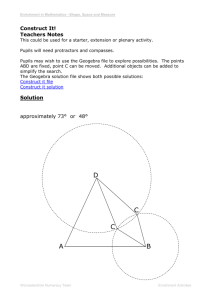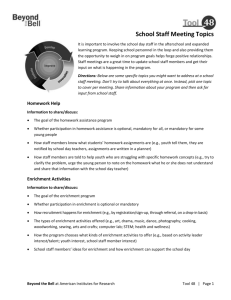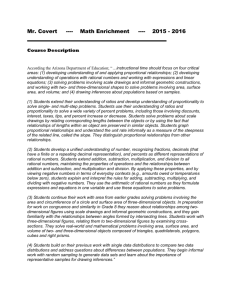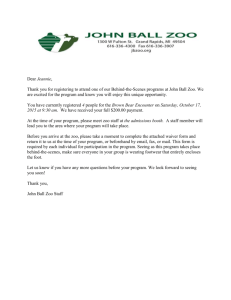Project Proposal
advertisement
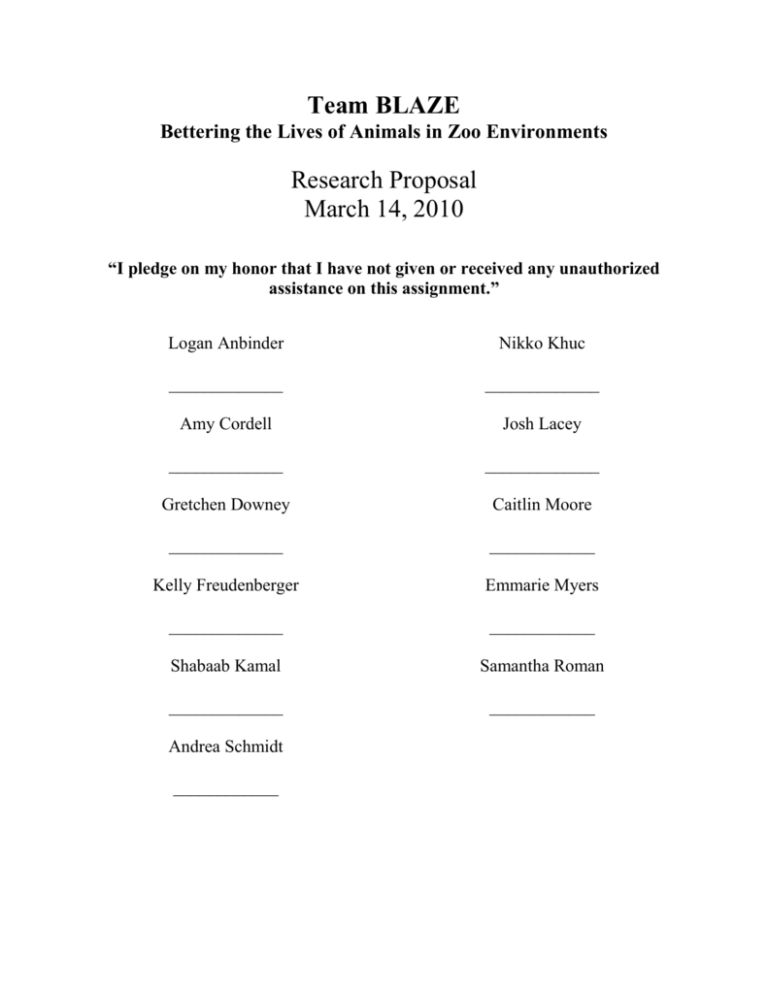
Team BLAZE Bettering the Lives of Animals in Zoo Environments Research Proposal March 14, 2010 “I pledge on my honor that I have not given or received any unauthorized assistance on this assignment.” Logan Anbinder Nikko Khuc _____________ _____________ Amy Cordell Josh Lacey _____________ _____________ Gretchen Downey Caitlin Moore _____________ ____________ Kelly Freudenberger Emmarie Myers _____________ ____________ Shabaab Kamal Samantha Roman _____________ ____________ Andrea Schmidt ____________ 1 TABLE OF CONTENTS Abstract……………………………………………………………………………………………3 Section 1: Introduction ……………………………………………………………………………3 Research Problem……………………………………………………………………...….3 Research Question………………………………………………………………………...4 Hypothesis………………………………………………………………………………...4 Project Justification…………………………………………………………………….…4 Section 2: Literature Review……………………………………………………………………...5 Enrichment ………………………………………………………………………………..6 Felids ...……………………………………………………………………………………7 Corticoid Analysis ……………………………..…………………………………….……8 Section 3: Methodology………………………………………………………………………….11 Experimental Design……………………………………………………………………..12 Data Analysis ……………………………………………………………………………14 Limitations ………………………………………………………………………………15 Section 4: Conclusion……………………………………………………………………………17 Works Cited………………………….……………………………………………………….….19 Appendices A: Glossary………………………………………………………………………………22 B: Budget…………………………………………………………………………….......23 Table 1…………………………………………………………………………………...24 2 Abstract Wild animals, particularly felids, experience stress in captive environments that may lead to disease and diminished fecundity. Enrichment has been shown to reduce this stress. In this study, sensory, manipulative, and feeding enrichments will be added to the existing lion and tiger exhibits at the National Zoological Park in Washington, D.C. Observational and hormonal data will be collected and analyzed, and it is predicted that enrichment will result in decreases in fecal corticoid levels and increases in non-stereotypic activity. By differentiating between the effectiveness of multiple types of enrichment, we can determine the enrichment most suitable for specific felid species and provide them with stimuli that encourage more natural behaviors. Introduction Research Problem Despite the best attempts of the zoo community, animals’ enclosures will never be true representations of their natural habitats because they are small and synthetic exhibits. As a result, animals tend to use coping mechanisms known as stereotypies (or abnormal repetitive behaviors) in order to relieve stress induced by the captive environment (Pitsko 2003). Stress may cause reduced fecundity and can be detrimental to animals’ mental and physical health (Van Metter et al. 2008). Captive felids are particularly susceptible to these adverse affects. Additionally, when animals exhibit more natural behaviors they act as better representations of their species in order to educate the public, serve as research subjects, and encourage greater conservation. Solving stress-related problems is thus in accordance with three goals of the zoo community, which are “conservation, research… [and] education” (Churchman 1987). 3 Research Question Our overarching research question is, “How do various types of enrichment, including sensory, manipulative, and feeding, affect the activity budget and fecal corticoid levels of felid species in a zoo environment?” We are testing the effectiveness of three different kinds of enrichments on two species of felids to assess which techniques are most effective in improving the quality of zoo animals’ lives. This improvement may be manifested in a more diversified activity budget and a decrease in stereotypies, if they are present. Hypothesis When enrichment of any type is added to the husbandry schedules of captive lions (Panthera leo) and tigers (Panthera tigris sumatrae), we hypothesize that there will be a difference in both the activity budgets and fecal corticoid levels of the subjects compared to the baseline (Skibiel et al. 2007). We expect that the animals’ fecal corticoid levels will decrease and their activity budgets will show more diverse behaviors, as well as generally higher levels of activity (Wielebnowski and Watters 2007). We also anticipate interspecific variance dependent on the type of enrichment, due to physiological and temperamental differences between lions and tigers (Van Metter et al. 2008). Project Justification Existing literature has determined that fecal corticoid levels are not always indicative of high, negative stress levels (2009 email from Nadja Wielebnowski to authors; unreferenced) and should not be used as the only measure of well-being. In addition to fecal analysis, direct observation can also be used to quantify stress levels (Skibiel et al. 2007). Therefore, this 4 research is novel in its combination of behavioral and hormonal indicators of stress levels, providing observational and physiological support for our claims. Additionally, little research has been done comparing the effectiveness of different classes of enrichment on individual species (Van Metter et al. 2008). This research will allow for broader generalizations about the effects of specific enrichments by using two felid species. Our research focuses on felids because of the negative effects that stress has on these captive animals’ fecundity (Terio et al. 2004). Previous studies suggest that decreased fecundity is linked to a heightened endocrine stress response, and we hope that by learning how to lower stress levels of captive felids, we will be able to understand how to more efficiently encourage felid reproduction in captivity (Jurke et al. 1997). Increasing felid fecundity will consequently aid zoos in their goal of conservation by providing subjects that most closely resemble their wild counterparts, and will further zoos’ additional goals regarding research and education (Ogden and Heimlich 2009). Literature Review As research has been conducted on the behavior of animals in captivity in the past, decision making processes in the zoological community have accordingly become more enlightened with regard to animal welfare. Zoos have successfully manipulated many factors, such as social density, housing design, and degree of autonomy, in order to provide more stimulating environments for animals in zoos (Maple 2007). Behavioral enrichment is one such factor often utilized to create an atmosphere of “activity, novelty, and flexibility” (Maple 2007), especially for felids. Behavioral enrichment may reduce stress levels in captive felids that often 5 lead to a wide array of vascular diseases, diseases which are generally observed only in captivity (Munson, 1993; Munson and Bolton, 1999). Enrichment Enrichment is the dynamic process that structures and changes an animal’s environment in a way that provides for behavioral choices and elicits species’ natural behaviors and abilities from the animal (Van Metter et al. 2008). Enrichment activities for felids can vary from exposing animals to stimuli such as frozen zebra dung and piñatas, to providing exercise courses and chase games (Van Metter et al. 2008). Studies have been conducted using different forms of enrichment in many different species, all with the goal of determining the effects of environmental changes on animal responses. For example, studies have shown that different felid species may vary in their reactions to enrichment activities, and slight environmental changes may alter specific biological functions, like eating patterns and reproductive hormone secretion (Skibiel et al. 2007; Clubb and Mason 2007). Van Metter et al. (2008) found that using frozen blood balls, fresh zebra dung, scented squash, and cardboard boxes had a substantially greater beneficial effect on African lions than on the Sumatran tigers. The African lions exhibited more active behaviors and slept less than the Sumatran tigers during the enrichment trials. The researchers also found that the animals did not habituate to the enrichment over the trial period. Moreira et al. (2007) found that changes in environmental enclosures caused the reproductive cycle in female tigrinas (Leopardus tigrinus) and margays (Leopardus wiedii) to change drastically. In this study, the two species differed in their physiological responses to environmental change. After being placed into a large environment, the animals were transferred 6 to a smaller enclosure. During the transfer, corticoid levels were measured to analyze the impact on estrogen and fertility cycles because corticoid and estrogen levels have been shown to be correlated. While fecal corticoid levels increased for both species, the effect was significantly greater for margays than for tigrinas. Felids The literature is abundant with studies showing the effects of captivity on the welfare of animals (e.g., Davey 2007; Clubb and Mason 2007; Terio et al. 2004). It has also been shown that felids cope with captivity particularly poorly. In a multi-species study of infant mortality rates of animals in captivity, three of the four most at-risk species were felids (Clubb and Mason 2007). In addition, most large felids are solitary carnivores, making the introduction of mates a potentially dangerous process that often leads to fighting, injury, or death (Shoemaker et al. 1997). The most common technique to enhance the welfare of captive animals is the use of enrichment, but large felids have proven to be particularly resistant to the effects of enrichment due to their naturally complex behaviors (Mellen and Shepherdson 1997). Additionally, temperament and personality have been proven to play a factor in a felid’s response to environmental enrichment (Boissey et al 2007). Different dispositions among individuals may lead to different behaviors and coping mechanisms in reaction to the same stimulus (Wielebnowski 1999). The level of fearfulness in animals has also been the subject of several studies. For example, one study illustrated that Merino ewes with a calmer temperament produce better quality milk and exhibit improved immune function and growth rate as compared to Merino ewes with a more fearful disposition (Boissey et al 2007). One study that focused on 7 cheetahs found that female cheetahs tended to have more fearful temperaments than males, and non-breeding cheetahs tended to be more fearful than breeding cheetahs (Wielebnowski 1999). The more fearful cheetahs tended to cope worse with the captive environment than those with less fearful temperaments, suggesting that the fearful individuals might require more hiding places in their exhibits (Wielebnowski 1999). Additionally, the lack of space in zoo environments makes it difficult to accommodate felids’ large ranging tendencies. Wide-ranging felids are accustomed to experiencing new environments frequently; therefore, static zoo environments impede the exhibition of natural behaviors. Furthermore, felids’ natural methods of hunting prey cannot be exercised due to the ethical and public concerns with live prey (Pitsko 2003). Mellen and Shepherdson (1997) found that cats quickly habituate to novel conditions, meaning that enrichment must be constantly altered and reintroduced in order to be effective in encouraging more natural behaviors. Lions have some of the most expansive ranges of the large felids, a factor that has contributed to a lack of reproductive success in captivity with infant mortality rates nearing 50% (Shoemaker et al. 1997; Clubb and Mason 2007). We are focusing on such species because we hope to facilitate more successful breeding in captivity and an increase in natural behaviors. Corticoid Analysis Fecal corticoid measurements are often used to monitor changes in animals’ stress levels. Because of the physiological connection to stress and the benefit of being non-invasive, fecal corticoid measurements have been implemented in many studies evaluating the effects of enrichment on an animal’s level of stress (Wielebnowski 2009). Through a chain of physiological events beginning with a perceived stressor, an animal’s body eventually secretes a 8 stress hormone corticoid which can be measured in the animal’s feces (Graham and Brown 1996). Corticoids are part of the hormonal response of the physiological stress reaction, and are excreted as waste in the feces. Therefore, measurements of hormonal levels in fecal samples can provide useful information about the activity of the hypothalamic-pituitary-adrenal axis (Wielebnowski 2003). Because of the ability to monitor stress responses practically and non-invasively, fecal corticoids are preferred over other methods such as blood sampling and urinary corticoid measurements. Though blood samples show instantaneous changes of various hormones related to stress, the simple act of collecting samples can actually increase stress in the animal and create a confounding variable. Urinary corticoid measurements, like fecal corticoid analysis, are also non-invasive, eliminating the possibility of inducing stress through sample collection. However, the practicality of this approach is limited because cats tend to spray, making it difficult to collect uncontaminated urine in sufficient quantities for analysis. A study of corticoid metabolism in domestic cats also showed that fecal corticoids better reflected the actual concentrations of stress hormones within the cat bloodstream than urinary corticoid measurements (Graham and Brown 1996). Fecal corticoids are measured with immunoassays, and all assays must be validated before use to ensure that the hormones of interest are measured accurately. It is vital to the integrity of any study that all assays and extraction techniques “detect biologically meaningful alterations in the endocrine status of the animals” (Touma 2005). Validation is comprised of two major aspects: analytical and physiological validity. Analytical validity refers to the sensitive of the assay to different levels of hormones, as well as the general accuracy and precision of the assay (Palme 2005). This can be established by using the assay to analyze several different 9 dilutions of the relevant hormone, and ensuring that the assay reflects the correct level of the hormone. Physiological validity refers to the assay being responsive to actual changes in circulating hormone levels. Establishing physiological validity involves pharmacologically inducing changes in corticoid levels in the bloodstream and assessing if the assay reflects those changes (Touma 2005). This is done by taking samples before and after events known to induce glucocorticoid change (e.g., exogenous administration of ACTH, stressful events such as veterinary exams) and seeing if the assay detects a marked change in hormone levels as a result. Validation, like all assay testing, is subject to individual fluctuations, particularly between genders and life-history stages, and as such, needs to be done with a large sample to eliminate such variation (Palme 2005). Though fecal corticoid levels can provide important data, the results cannot serve as the sole basis for conclusions regarding an animal’s stress level. This is because corticoid has a natural circadian rhythm that fluctuates throughout the course of the day and corticoid levels vary widely among individual animals. Measurement of fecal corticoid levels is an average measurement of this fluctuation. There are many factors within the nervous system, including regulation of the neurotransmitters involved in the stress response, which may alter corticoid levels in the feces. Additionally, normal corticoid ranges vary between individual organisms, as every animal is biologically different. High corticoid levels indicate the presence of stress, but it is impossible to differentiate between eustress, which might be the result of increased activity or interaction with other animals, and distress, which may result from anxiety and boredom (Wielebnowski 2009). Also, there are several limitations on sample reliability. These include the freshness of the sample, possible environmental contamination of the sample, and urine 10 contamination of the sample that may occur when another animal tries to mark its territory (Wielebnowski and Watters 2007). Fecal corticoid measurements alone are thus insufficient for making conclusions about the overall stress level of an animal. In order to compensate for such limitations, corticoid measurements are most valuable when analyzed in the context of additional data, such as behavioral data. Methodology We will conduct our research at the Smithsonian National Zoological Park in Washington, D.C. using Sumatran tigers and African lions during the summers of 2010 and 2011. We will conduct pilot testing in the beginning of the first summer to determine the schedule that best fits with established zoo protocols and husbandry practices. We will use a within – subject design, which involves collecting data before, during, and after implementation of the enrichment, allowing each felid subject to serve as its own control by providing its own baseline (Graziano and Raulin 2007). Timeline for Individual Trials Experimental Design 11 There will be two trials for each of the three types of enrichment, with each trial lasting five consecutive days. These six trials will take place during the first summer of research in 2010. We will observe each animal’s behavioral responses to the enrichment and collect fecal samples for later analysis. Behavioral observation will be conducted at the same time each day in order to account for the potentially confounding effects of circadian rhythm on activity levels (Liu et al. 2006). Observations will be quantified based on the duration and frequency of each behavior exhibited, and an activity budget for each animal will be constructed for each time period (baseline, during enrichment, and after enrichment). These activity budgets will then be compared to determine if our enrichment results in altered activity levels or activity budgets. We will also complete research during the summer of 2011 during which each trial will involve a combination of enrichments. This will involve a combination of sensory, manipulative, and feeding enrichment. For example, we could supply a manipulative object such as a cardboard box and have inside of this box a unique food object. The methodology will remain the same, but there will be an added level of complexity to the enrichments that are introduced. We will compare the data collected during the more complex trials with values collected from the first summer. Pilot Testing Before beginning experimental manipulation, we will conduct pilot testing to establish the normal patterns of behaviors and hormone secretion for each animal. We must determine the degree to which hormone levels fluctuate naturally before attempting to determine if our experimental manipulation incited the changes. For three weeks before applying our enrichments, we will observe all potential subjects at different two-hour intervals throughout the 12 day. Time of observation will be randomized for this trial period in order to eliminate seasonal confounds. This will allow us to establish the optimal time, determined by the presence of stereotypic behaviors, to conduct our experiment with enrichment. At the conclusion of the observational period, we will analyze all of the daily fecal samples in order to characterize normal corticoid levels and daily fluctuations. During this time, we also plan to conduct at least one inter-observer reliability test in order to make sure all observers are quantifying observations accurately and consistently. Establishing Baseline Once we begin our experimental manipulation, we will establish the baseline activity budget and fecal corticoid levels for each animal for the week. Baseline observational data will be collected for each animal on Day 1 and Day 2, during the optimal time determined in pilot testing. In order to establish the baseline fecal corticoid levels, the zoo staff will collect all available fecal samples from Day 1 and Day 2. To allow for individual identification of fecal samples, plastic pellets in a color unique to each individual will be added to each animal's food in the days prior to fecal sample collection. Enrichment Application On Day 3, one type of enrichment will be added into the exhibit when our subjects are present. The order in which each type of enrichment is provided to the animal will be randomized to prevent habituation to a particular pattern of testing. After implementing the enrichment, we will observe the animals’ behaviors, using the same techniques described for baseline data collection. The enrichment will stay in the enclosure for the remainder of the day. 13 We will collect all available fecal samples each of the five days, and our behavioral observations will continue on Day 4 and Day 5. This period should allow us to document the return of behavior and corticoid levels to baseline before the next trial begins. This procedure will be repeated for the remainder of the trials. During observations, we will record the type and duration of each behavior expressed by the study subjects using JWatcher software, which allows for compilation and analysis of behavioral data. The observers will record specific behaviors, which will later be classified by category. These categories will be defined by an ethogram. Our activity budgets will be established from the results of pilot testing. Data Analysis For each animal, we will compare the duration of active, inactive, and stereotypic behaviors as well as the overall activity budget before, during, and after the implementation of the enrichment. Data collected with JWatcher will be used to test for statistical differences between the three periods of observation. The baseline activity budget will be compared to the activity budget from Day 3 in order to identify which type of enrichment most increases active behaviors while decreasing stereotypic and passive behaviors. Data for each species will be analyzed separately to determine the most effective type of enrichment for each species. Because of the similar body types of the two field species, we may be able to generalize to similar-sized felids should strong similarities exist between the data sets. The fecal corticoid analyses will be conducted at the Department of Reproductive Sciences at the Smithsonian National Zoological Park, using established protocols. Fecal samples will be analyzed by extracting the corticosterone from the sample, then using previously 14 validated enzyme immunoassays to determine corticosterone concentrations. We will analyze fecal corticosterone levels and activity budgets for each animal, and examine the corticosterone levels for overall trends throughout the trial period. Limitations A significant limitation of this study is that much of the data collection depends on the animal husbandry schedules; therefore the specific time periods of data collection and enrichment introduction are subject to change based on input from zoo staff. Additionally, changes to the enclosure or to the daily schedule of the felids that are outside of the team’s environmental manipulation techniques could have a significant impact on the results. If the zoo staff were to change the feeding schedule of the felids, or add or remove objects from the enclosures, the team would be unable to attribute changes in the activity budget or fecal corticoid levels to the enrichment techniques we implement rather than the changes made by the zoo. If this were to happen, we may draw incorrect conclusions about the effectiveness of the enrichment items that we manipulated. The various ages and genders of the felids also present a limitation, because they result in the formation of social groups, requiring them to be on exhibit at different times of the day. Therefore, we must consider the rotation schedule at the zoo in our plans, so that we have a consistent group of felids to test and monitor. If data is collected from felids immediately after they are transported to the zoo from other facilities, the fecal corticoid data levels will be skewed, as corticoid levels can increase dramatically for almost two weeks after time of relocation of the animal (Dembiec et al. 2004). 15 Another potential limiting factor is individual personality differences in the lions and tigers. An animal’s temperament affects its ability to cope with captive environments and novel situations (Wielebnowski 1999). For example, the subjects’ personalities may be more aggressive, calm, fearful, or excited. This will affect how each animal responds to the enrichment items, and animals with different personalities will react based on their own personality traits. We may not know if a subject is not interacting with the enrichment item because of its temperament or because the enrichment item fails to elicit active behaviors. Talking to the zoo staff who work with the lions and tigers on a regular basis will help decrease individual temperament as a confounding variable. We will have to know each animal’s personality based on its interactions and observations by the zoo staff before conducting our studies. The personalities will also be taken into account when analyzing the effectiveness of the enrichment trials. Because one of the main methods of data collection is through observation of the felids’ behavior, differences between observers’ perceptions of the behavior could cause discrepancies; however, the design of our experiment reduces inter-observer bias. We will attempt to minimize such bias and inconsistencies by testing inter-observer reliability during pilot testing. Finally, defining specific behaviors with an ethogram will decrease observer bias, and the data will be more reliable. Due to seasonal variability, weather presents an additional variable. Since fecal corticoid levels vary throughout different seasons in felids, we will establish a baseline for each felid per trial to eliminate seasonal fluctuations as an extraneous variable (Wielebnowski and Watters 2007). Because weather cannot be accurately predicted in advance, inclement weather may interfere with data collection and animal behavior. A note of basic weather conditions (e.g., 16 temperature, precipitation) will be made when collecting data, so that this can be accounted for in subsequent statistical analyses. The characteristics of visitor activity including density and level of activity of the visitors have been proven to alter animal behavior both in positive and negative ways (Davey 2007). Because visitor levels at the zoo cannot be controlled, a new extraneous variable is introduced into the experiment. Visitor levels might cause fluctuations in animal behaviors or fecal corticoid levels that interfere with our data, causing uncertainty in determining whether the introduced enrichment caused the fluctuation. By conducting our research on weekdays only, we aim to decrease the effect of differing visitor levels. However, we will collect data from the zoo regarding the number of visitors each day of our research, in order to take this factor into consideration. Illnesses and genetic ailments cannot always be prevented, and may present as an additional confounding variable in our study. If a felid were to become ill during the study, corticoid levels could fluctuate based on the illness rather than our manipulations. The behavioral observations and records should also reflect the effects of the illness on the felid’s activity budget. Data from any ill animal will be excluded from our final analysis. Conclusion In general, felids are more susceptible than other common zoo species to the adverse effects of stress in a captive environment. This is a particular cause for concern due to the necessity of conservation and preserving genetic diversity within these species. Additionally, animals that act naturally are better tools for education, and more likely to attract visitors than those that act stereotypically or lethargically. We plan to combine behavioral observation and 17 corticoid level analysis in order to provide valid indications of stress levels in the animals studied. Through the novel combination of behavioral and physiological data, we will study the effects of sensory, manipulative, and feeding enrichments on two different felid species, in order to determine which method is most effective in stimulating active behaviors while simultaneously reducing stress levels for each species. We believe that our results can be generalized to other zoos, providing valuable information to animal care experts about ways to improve the well-being of captive felids. 18 WORKS CITED Churchman D. 1987. The educational role of zoos: A synthesis of the literature (1928-1987) with annotated bibliography. ERIC Document Reproduction Service No. ED287942 Clubb R and Mason GJ. 2007. Natural behavioural biology as a risk factor in carnivore welfare: How analysing species differences could help zoos improve enclosures. Applied Animal Behaviour Science 102(3-4):303-328. Davey G. 2007. Visitors' effects on the welfare of animals in the zoo: A review. Journal of Applied Animal Welfare Science 10(2):169-183. Dembiec DP, Snider RJ, and Zanella AJ. 2004. The effects of transport stress on tiger physiology and behavior. Zoo Biology: Wiley-Liss Inc. 23(4):335-346. Graetz M. 1995. The role of architectural design in promoting the social objectives of zoos: A study of zoo exhibit design with reference to selected exhibits in Singapore zoological gardens [dissertation]. National University of Singapore. sec. glossary. Graham LH and Brown JL. 1996. Cortisol metabolism in the domestic cat and implications for non-invasive monitoring of adrenocortical function in endangered felids. Zoo Biology 15(1):71-82. Graziano A and Raulin M. 2007. Research methods. Boston: Allyn and Bacon. Jurke MH, Czekala NM, Lindburg DG, and Millard SE. 1997. Fecal corticoid metabolite measurement in the cheetah (Acinonyx jubatus). Zoo Biology 16(2):133-147. Lequin RM. 2005. Enzyme immunoassay (EIA)/enzyme-linked immunosorbent assay (ELISA). Clinical Chemistry 51:2415-2418. Liu J, Chen Y, Guo L, Gu B, Liu H, Hou A, Liu X, Liu, Sun L, and Liu D. 2006. Stereotypic behavior and fecal cortisol level in captive giant pandas in relation to environmental enrichment. Zoo Biology 25:445-459. MacDonald JA, Shahrestani S, and Weis JS. 2009. Behavior and space utilization of two common fishes within Caribbean mangroves: Implications for the protective function of mangrove habitats. Estuarine, Coastal, and Shelf Science 84(2):195-201. Maple T. 2007. Toward a science of welfare for animals in the zoo. Journal of Applied Animal Welfare Science 10(1):63-70. Mellen JD and Shepherdson DJ. 1997. Environmental enrichment for felids: An integrated approach. International Zoo Yearbook 35(1):191-197. 19 Moreira N, Brown JL, Moraes W, Swanson WF, and Monteiro-Filho ELA. 2007. Effect of housing and environmental enrichment on adrenocortical activity, behavior and reproductive cyclicity in the female tigrina (Leopardus tigrinus) and margay (Leopardus wiedii). Zoo Biology 26:441-460. Munson L. 1993. Diseases of captive cheetahs (Acionyx jubatus): Results of the cheetah research council pathology survey. Zoo Biology 12:105-124. Munson L, Nesbit JW, Meltzer DGA, Colly LP, Bolton L, and Kriek NPJ. 1999. Diseases of captive cheetahs (Acionyx jubatus jubatus) in South Africa: A 20 year retrospective survey. Journal of Zoo and Wildlife Medicine 30:342-347. Ogden J and Heimlich JE. 2009. Why focus on zoo and aquarium education? Zoo Biology 28:357-360. Palme R. 2005. Measuring fecal steroids. Annals of the New York Academy of Sciences (1046):75-80. Pitsko LE. 2003. Wild tigers in captivity: A study of the effects of the captive environment on tiger behavior [Internet]. [Blacksburg, Va.: University Libraries, Virginia Polytechnic Institute and State University]. Available from: http://scholar.lib.vt.edu/theses/available/etd-05122003-134456. Shoemaker AH, Maruska EJ, and Rockwell R. 1997. Minimum husbandry guidelines for mammals: Large felids [Internet]. American Association of Zoos and Aquariums. Available from: http://nagonline.net/HUSBANDRY/husbandry_manual_chapters.htm. Skibiel AL, Trevino HS, and Naugher K. 2007. Comparison of several types of enrichment for captive felids. Zoo Biology 26:371-381. Terio K, Marker L, and Munson L. 2004. Evidence for chronic stress in captive but not freeranging cheetahs (Acinonyx jubatus) based on adrenal morphology and function. Journal of Wildlife Diseases 40(2):259-266. Touma C and Palme R. 2005. Measuring fecal glucocorticoid metabolites in mammals and birds: The importance of validation. Annals of the New York Academy of Sciences (1046):5474. Utah’s Hogle Zoo – Types of Enrichment. Salt Lake City (UT): Hogle Zoo [cited 2009 Oct 4]. Available from https://www.hoglezoo.org/meet_our_animals/animal_enrichment/ enrichment_types/. Van Metter JE, Harriger MD, and Bolen RH. 2008. Environmental enrichment utilizing stimulus objects for African lions (Panthera leo leo) and Sumatran tigers (Panthera tigris sumatrae). BIOS 79(1):7-16. 20 Van Praag H, Kempermann G, and Gage FH. 2000. Neural consequences of environmental enrichment. Nature Reviews: Neuroscience 1:191-198. Wielebnowski N. 1999. Behavioral differences as predictors of breading status in captive cheetahs. Zoo Biology 18:335-349. Wielebnowski N. 2003. Stress and distress: Evaluating their impact for the well-being of zoo animals. Journal of American Veterinary Medical Association 223(7):973-976. Wielebnowski N and Watters JV. 2007. Applying fecal endocrine monitoring to conservation and behavior studies of wild mammals: Important considerations and preliminary tests. Israel Journal of Ecology & Evolution 53(1):439-460. 21 Appendix A: GLOSSARY Activity Budget: A tool used to illustrate the frequency of previously defined behaviors that are exhibited by the subjects (MacDonald 2009). Enrichment: A way of “[increasing] the complexity of the captive environment and possibly [enhancing] captive animals’ well-being by stimulating active behaviors and reducing stereotypical behaviors commonly seen in zoo felids” (Skibiel 2007). Enzyme Immunoassays: An assay technique that utilizes enzymes as reporter labels to measure analytes within a sample (Lequin 2005). Feeding enrichment: “a variety of task oriented puzzle feeders and different methods of presentation encourage animals to think and work for their food, as they would in the wild” (Hogle 2009) Manipulative enrichment: “items (such as barrels, balls, or boxes) that can be manipulated in some way via hands, mouth, legs, horns or head simply for investigation and exploratory play” (Hogle 2009) Ranging Tendency: the average distance a species travels in a given period of time in a typical, natural setting (Terio et al 2004) Sensory enrichment: “techniques such as bubbles, scents, or video recordings that would stimulate…the animals’ senses- visual, olfactory, auditory, taste and tactile” (Hogle 2009) Stereotypies: Abnormal repetitive behaviors exhibited by animals, often in response to stress; also known as stereotypic behaviors (Pitsko 2003) 22 Appendix B: BUDGET Expenses Cost 0.00 ~400.00 ~400.00 0.00 JWatcher Software (available online) Manipulative enrichment materials Feeding enrichment materials Sensory enrichment materials (Animal scents will be provided by the Zoo) Fecal Corticoid Immunoassay Kits (45 samples/animal x 12 animals at $7/sample) Round trip transportation to the zoo from College Park (5 observers x 55 days/observer x $5/trip) 7560.00 2750.00 Total 11110.00 *For two summers of research 23 Table 1. FELID BEHAVIORS* Active Behaviors Feeding Social interaction Locomotion Alone play Rolling Swimming Alert Scent marking Vocalization Eating, drinking, chewing, or licking edible substances Engaging in behavior towards another, including social grooming Walking, running, climbing Partaking in playful activities alone Rotating side to side while laying down Any activity done in the water Eyes open and aware of surrounding, not engaged in other activities Releasing spray from posterior on an object or area Making noises with the mouth Inactive Behaviors Sleeping Laying down Sitting Grooming Urinating/defecating Laying down with eyes closed Laying down with eyes open, not alert Hind legs on ground, upper body upright, not alert Licking or scratching itself Projection of bodily fluids other than scent-marking Stereotypic Behaviors Pacing Biting at fur Walking a regular bath repetitively, path may be well worn Biting at fur, outside of self-grooming behaviors * ethogram modeled from Skibiel et al. (2007) and Van Metter et al. (2008). 24
